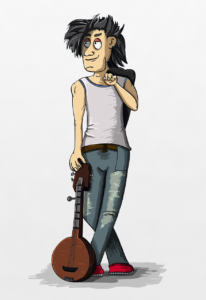The character development process can be one of the most fun and exciting when starting a new novel. But where do you start? What are the critical components of a good character? And how can you generate ideas for exciting characters?
This blog post discusses character development and helpful tips for creating believable and compelling characters. So whether you are just starting or stuck in writer’s block, read on for some inspiration!
Introduce the different types of characters you might use in your thriller novel
One of the most important aspects of writing a good thriller novel is creating believable and compelling characters. To do this, you need to understand the different types of characters that you can use in your story.
There are four main character archetypes: the protagonist, the antagonist, the love interest, and the supporting cast. Each archetype has different components to consider when you create characters.
Examples of each type of character
The Protagonist: The protagonist is the main character of the story and is typically the one who is driving the plot forward. They should be relatable and have a clear goal that they are trying to achieve.
The Antagonist: The antagonist is the character who opposes the protagonist and is usually responsible for any conflicts that arise. They should be well-developed and have their motivations for why they are doing what they are doing.
The Love Interest: The love interest is a character attracted to the protagonist. They can help further the plot and add some emotional depth to the story but are not necessarily essential to the plot.
The supporting cast: These are the different characters who help to move the story along but are not as integral to the plot as the other three character types.
Now that you know the different character archetypes, it’s time to start thinking about which ones would be right for your story. The best way to do this is to brainstorm a list of potential characters and then narrow it down based on the story’s needs.
A few things to keep in mind when brainstorming character ideas

– What kind of story are you telling? Is it a fast-paced thriller or a more character-driven drama?
– What is the setting of your story? Is it in a small town or a big city?
– What is the tone of your story? Is it light-hearted or more serious?
Once you understand what you want your story to be, you can start thinking about which character archetypes would fit nicely into it.
For example, if you’re writing a thriller set in a big city, you might want to include a character like a femme fatale or a tough cop.
If you’re not sure where to start, here are a few character ideas to get you thinking
– The loner: This character is often misunderstood and keeps to themselves. You might perceive them as cold or unfriendly, but they usually prefer to be alone. They’re often seen as mysterious or dangerous because people don’t understand them.
– The manipulator: This character is always trying to get one over on others. They’re smooth talkers and often seem in control, even when they’re not.
– The optimist: This character always sees the best in people and situations, even when it’s not warranted. They’re the type of person who believes that everything will work out in the end.
– The cynic: This character is the opposite of the optimist. They tend to be negative and sarcastic and don’t have much faith in people.
– The go-getter: This character is always striving to achieve their goals. They’re ambitious and driven, and they don’t let anything or anyone get in their way.
– The overthinker: This character can’t help but overthink everything. They are constantly second-guessing themselves and their decisions, often leading to indecision.
– The underachiever: This character is someone who could achieve great things, but they don’t because they lack motivation. They’re content with getting by and don’t see the point in pushing themselves to do more.
– The control freak: This character likes to be in control of everything and everyone around them. They are often seen as bossy, manipulative, and striving to be in charge.
– The lost soul: This character is searching for something, but they don’t know what it is. They often feel adrift in the world and struggle to find their place in it.
– The outcast: This character doesn’t fit in with the rest of society. They are different in some way, their physical feature, abilities, or views. They’re often misunderstood and mistreated by others, but they can also be solid and resilient.
These are just a few examples of the many different types of characters you could create for your next thriller novel. By thinking about the various components that make up a character, you can come up with endless possibilities for who your protagonist and antagonists might be. So get creative and see what you can come up with!
How to create a well-rounded cast of characters for your story

The number one rule for creating a well-rounded cast of characters is simple: make sure each character serves a specific purpose, and every Important character has a Public face and a Private face.
Starting with the most dynamic characters, the main characters:
The main antagonist should have the broadest range of emotions, motivations, and reactions.
The lead protagonist needs to be strong but also human and fallible. Be sure to give your readers someone to root for!
But don’t forget the sidekicks, the love interests, the mentors, etc. Each supporting character should contribute something unique to the story. Individually they may not be as intriguing as the lead characters, but together they should create an unforgettable cast.
Here are a few more tips:
– Antagonists should be active, not passive. They should drive the story forward, not just react to the protagonist.
– The lead character’s motivation should be clear from the start; what they want and why they want it.
– Make sure your characters are relatable and sympathetic, even the villains. Readers must understand why they do what they do, even if they disagree.
Now let’s look at some examples of characters from popular thrillers. Remember, you can use these as inspiration for your work, but don’t copy them directly.
– In Gone Girl, Amy Dunne is the perfect example of an unreliable narrator. The reader is never quite sure what she will do next, which keeps them hooked until the end.
– In The Girl on the Train, Rachel is a character with a clear motivation: she wants to find out what happened to Megan Hipwell. However, her alcoholism and mental health issues make her an unreliable narrator, making the mystery even more suspenseful.
– In The Silence of the Lambs, Hannibal Lecter is a chilling character who is both intelligent and dangerous. His scenes are some of the most memorable in the movie, and his character will stay with you long after you’ve finished watching.
Tips for developing your characters’ personalities and motivations
Give them a personality that is relatable and believable

To create a well-rounded cast of characters for your story, you need to ensure that each character has a distinct personality and role. You also want to ensure that your characters are relatable and believable. One way to do this is to give them flaws and weaknesses that make them human. You might even want to add a unique quirk to one of them.
Character quirks are small, often amusing details that make a character more distinctive and memorable. Quirks can be physical (like a stutter or a limp), behavioural ( like always carrying a notebook or wearing gloves), or psychological (like being obsessively tidy or highly suspicious). They add flavour to a story and can reveal important aspects of a character’s personality.
While some quirks are essential to defining a character, others are delightful little details that add interest and fun to the story. For example, J.K. Rowling’s Harry Potter is distinguished by his scar, but he also has several endearing quirks, like his love of broomsticks and his hatred of socks.
You can also deepen your character by giving them a backstory and clarifying their motivation. By understanding why your character does what they do, you can create a more believable and compelling character.
Make sure your characters are consistent
Another critical aspect of creating believable characters is ensuring they are consistent, meaning their actions and words should match their personality and motivations. If a character is supposed to be kind, they shouldn’t do something cruel without a good reason.
If you’re looking for more character inspiration, check out characters for your story ideas online. You can also browse character bio templates to understand better how to flesh out your personality.
Discuss ways to make your characters seem realistic and three-dimensional
One way to create believable characters is by understanding why they do what they do. Their motivations can be anything from wanting to save the world to getting revenge. Fleshing out your character with a detailed character bio will also help make them seem more real.
Another critical aspect of creating believable characters is ensuring their dialogue sounds natural. Take the time to read your character’s dialogue out loud to see if it sounds like something a person would say.
Finally, avoid making your characters too perfect or too evil. We all have flaws, and readers will be able to relate to characters who do as well. The same goes for making a character too good – it’s just not believable.
Plot ideas that could be used with the different types of characters presented

-A character with a dark past could be struggling to keep their true identity hidden while also trying to solve a crime.
-A character always putting others first could find themselves in danger when they try to help someone they barely know.
-A character obsessed with justice could go on a vigilante crusade to take down a group of criminals, only to find out that the law is not always black and white.
Conclusion
Now that you understand the different types of thriller novel characters, how to create a well-rounded cast and the importance of developing your characters’ personalities and motivations, it’s time to start putting all this information into practice.
Start by creating detailed character sketches for each of your leading players. These sketches should include physical descriptions, backstory, personality traits, emotional states, goals and motivations, and other essential details that will help bring your characters to life on the page.
Once you have your character sketches, start thinking about what scenes you’ll need to dramatize to show off your characters’ strengths and weaknesses. By developing solid and believable characters, you’ll give yourself a much better chance of writing a successful thriller novel that readers won’t be able to put down.
If you’re working on your first novel and are looking for more help with your writing, please check out our other articles at https://ullahakanson.com/blog/
Best of luck with your writing!
Ulla

